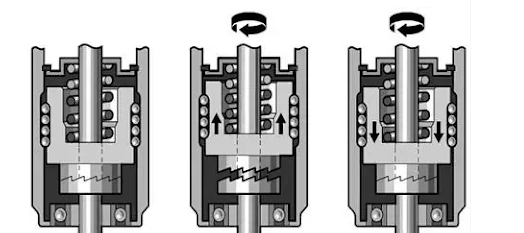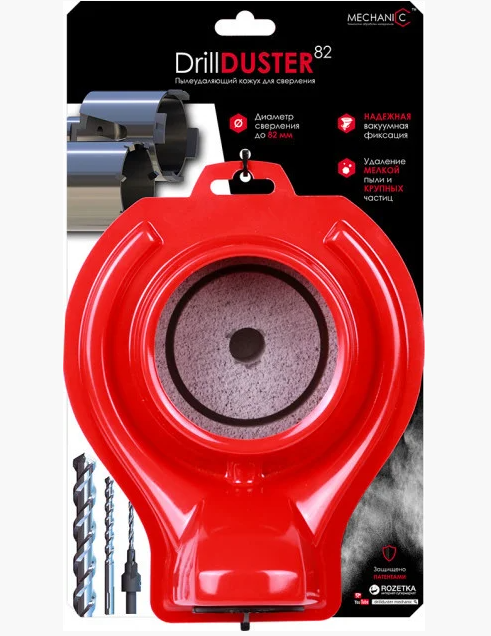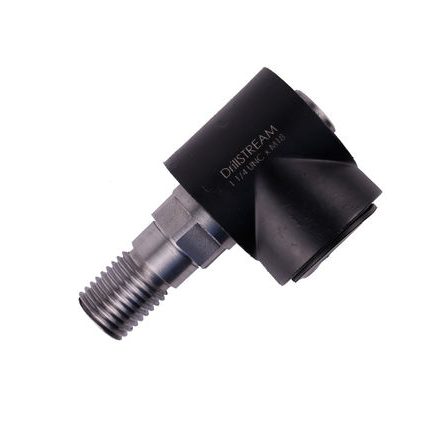Drilling with micro-impact
The world does not stand still, and diamond technologies are constantly evolving, allowing various tasks to be performed faster and more efficiently.
Not long ago, special dry drilling machines with micro-impact technology appeared on the market and quickly gained popularity.
Thanks to this technology, the speed of dry processing of construction materials has increased several times! This is exactly the technology we would like to tell you about.
Micro-impact system design
This system in diamond drilling machines operates on a principle similar to a standard hammer drill.
The mechanism consists of two ratchets whose teeth engage and disengage during rotation, creating a small impact.

Thanks to the high rotation speed of this equipment, a very high impact frequency is achieved — up to 50,000 impacts per minute. Did you know that drilling construction materials with a diamond bit is essentially micro-scratching the material with the diamond edges?
However, working with micro-impact is not just scratching — it combines scratching and crushing. Crushing is a less energy-consuming and more productive process. That is why the drilling speed with micro-impact is significantly higher than with conventional drilling.
Micro-impact drilling machines differ from rotary hammers and regular impact drills in many parameters. What should you pay attention to when choosing such equipment?
-
Power
-
Spindle rotation speed
-
Number of impacts per minute
-
Maximum allowed diameter of the tool
-
Spindle mounting type
-
Dust extraction capability
-
Possibility of mounting on a stand
In addition to these parameters, there is another factor that almost no manufacturer specifies — impact amplitude. According to our research, this value can range from 0.3 mm to 0.85 mm and depends on the height of the ratchet teeth.
With a small impact amplitude, the operator practically does not feel any vibration during operation, making the process much more comfortable. However, as the amplitude increases, vibrations become more noticeable.
Besides operator fatigue, the impact amplitude greatly affects the drill bit’s lifespan and — to a lesser extent — the drilling speed. The stronger the impact, the shorter the bit’s lifespan.
Currently, there are not many models of micro-impact drilling machines on the market, but their characteristics can vary significantly.
Most Popular Equipment
Above, we’ve already mentioned the key parameters to pay attention to when choosing such drilling machines.
Now, let’s dive deeper into this topic and examine in detail how these parameters differ across the most widely used micro-impact drilling models.
| Brand | Model | Power (kW) | RPM | Impacts/min | Max Ø (mm) | Mount |
|---|---|---|---|---|---|---|
| Eibenstock | ESD 1801 | 1,8 кВт | 2050 | 41000 | 90 | М18 |
| Milwaukee | DD2-160XE | 1,5 кВт | 1500 (890) 3000 (1770) |
48000 | 162, 90 | М18 |
| AEG | DB 1500-2XE | 1,5 кВт | 1500 (890) 3000 (1770) |
48000 | 162, 90 | М18 |
| Cayken | SCY-916PD | 2,3 кВт | 1700 | 34000 | 160 | 1 1/4 UNC 1/2 GAS |
| Cayken | SCY-18/2PA | 1,9 кВт | 720 1230/1780 |
28000 30240 |
132 | М18 |
| KEOS | PULSAR KS-180 | 2,3 кВт | 950 1700 |
34000 | 162 | 1 1/4 UNC 1/2 GAS |
| WEKA | DSK15SP-L | 2,0 кВт | 900 (540) 2000 (1200) |
- | 200 | 1 1/4 UNC |
| BAIER | BDB 829 | 2,15 кВт | 725 1500 |
14500 30000 |
252 | 1 1/4 UNC 1/2 GAS |
| BAIER | BDB 825 | 1,8 кВт | 1150 | 28000 | 200 | 1 1/4 UNC 1/2 GAS |
| Cardi | DP2200 ME-16 | 2,2 кВт | 1200 (880) | 28800 21000 |
162 | 1 1/4 UNC |
| Cardi | P2000 MS-13-K | 2,0 кВт | 2000 (1350) | 34000 23000 |
162 | М18 |
| Cardi | DPH 3000 ME-17 | 3,0 (3,65) кВт | 1250 (840) | 30000 20160 |
202 | 1 1/4 UNC |
| Cardi | DPH 3500 SE | 3,42 (4,4) кВт | 668 (438) 1096 (718) 1826 (1196) |
16030 (10500) 26297 (17221) 43828 (28701) |
350 | 1 1/4 UNC |
| AGP | DM52D | 1,8 кВт | 1800 3600 |
- | 160 | 1 1/4 UNC |
| AGP | DM51D | 1,8 кВт | 3600 | - | 80 | 1 1/4 UNC |
| Baumax | OND-916PD-G | 2,3 кВт | 1700 | 34000 | 168 | 1 1/4 UNC 1/2 GAS |
As we can see, the main parameters of drilling machines can vary greatly between manufacturers, and the availability of a stand for a specific model is a very important factor when choosing equipment.
A stand often allows drilling with much larger diameters than when using the machine manually.
Application
Micro-impact drilling is most commonly used on high-strength and even hydraulic-grade concrete, especially where using water cooling is not allowed on-site.
When passing through metal reinforcement, it is recommended to switch off the micro-impact mode (this feature is available on all models) to reduce vibration load on the operator and prevent excessive wear on the drill bit.
Today, micro-impact technology is becoming more popular even on simpler projects (apartment, office, or store renovations) because it allows working much faster and completing more jobs in less time.
For example, drilling socket holes in an ordinary apartment with M400 concrete walls:
-
Using a hammer drill, one hole takes about 4–5 minutes.
-
Drilling 70 holes would take 5–6 hours of pure drilling time.
-
With micro-impact, one hole takes about 1 minute, so the whole job takes just over an hour.
This is not only a huge time saving but also significantly reduces operator fatigue because drilling with micro-impact requires minimal effort.
Proper technique involves gently rocking the drill bit inside the hole to improve dust removal. This also helps sharpen the segments of the diamond core bit, ensuring consistently high processing speed.
Without this technique, the bit risks jamming, slowing down the rotation, or even stopping the machine — especially when drilling deeper holes.
However, rocking should be done with a small deviation angle (5–10 degrees), to avoid uneven wear or segment bending.
Drill Bits for Micro-Impact Work
Can regular diamond bits be used for micro-impact drilling? This is a common question from professionals who purchase this equipment.
Most bits designed for hammer drills or drilling rigs can technically work in micro-impact mode, but their lifespan will be greatly reduced.
That’s why special segments with reinforced diamonds are developed for micro-impact operation. Currently, ADTnS offers two such bits:
✅ CS-X — short bit with a drilling depth of up to 65–70 mm, designed for sockets and junction boxes. Available diameters: 68, 72, 82 mm. Mount: M16 with SDS Plus shank (adapter required for micro-impact machines).
It features oriented diamonds for stable performance throughout its lifecycle. The body has holes for dust extraction when used with special attachments.
✅ RS-TX — longer bit for holes up to 320 mm deep, and even deeper with an extension. Diameter range: 42 to 122 mm (10 mm step), mount: 1 1/4 UNC.
Ideal for drilling water pipes, air conditioners, etc. It also features oriented diamonds and a groove for better dust removal.
Additionally, Distar offers lightweight extensions for manual drilling (1 1/4 UNC thread, lengths 200 and 300 mm, weight 700g and 950g respectively).
Their precise manufacturing prevents increased run-out during use — perfect for HVAC, heating, and electrical installations where standard bit length isn’t enough.
Dust-Free Operation
Dust-free drilling is gaining popularity, especially for work in finished interiors where dry drilling creates heavy dust clouds.
Many clients are willing to pay more for a specialist who drills with dust extraction to avoid cleaning afterward.
However, not all micro-impact machines have built-in dust collection. That’s why Mechanic offers an effective and affordable solution:
✅ DrillDuster 82 — a dust extraction device for shallow drilling up to 82 mm diameter (perfect for sockets).
Made of durable materials and equipped with strong vacuum fixation, it sticks well to any surface.

Drillstream. This device allows for efficient dust extraction during deeper drilling since the dust is removed through the drill bit body. The Drillstream is installed between the drill bit and the spindle of the drilling machine.
It comes with two thread types — 1 1/4 UNC to 1 1/4 UNC and 1 1/4 UNC to M18. In addition to dust extraction, it also removes heat from the cutting zone, providing extra cooling for the drill bit during operation.

The company continues to innovate, and in the near future, special attachments will be introduced for dust extraction directly from the drill bit’s edge for CS-X drill bits.
Conclusions
Micro-impact drilling technology takes dry drilling to a completely new level. It allows work to be completed much faster while requiring significantly less effort.
Although this equipment is considerably more expensive, it’s important to remember that time is the most valuable resource. For professionals who provide dry drilling services regularly, the return on investment in micro-impact equipment is very high — and operator fatigue is much lower compared to those still drilling with a hammer drill!







